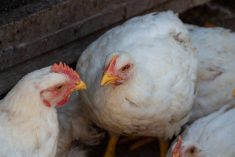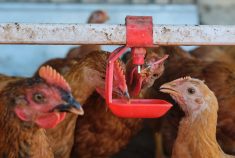Ontario farmers lining up to get in on a provincially-guaranteed electricity purchase program and install solar panels on their property may face a lower rate of return on their investments than their early-bird neighbours.
The Ontario Power Authority, which oversees the microFIT program, proposed Friday to cut the rate it pays on power generated from ground-mounted solar panels, to 58.8 cents per kilowatt-hour, down from the current rate of 80.2 cents/kWh.
The OPA said Friday it will “consult with applicants over the next 30 days about the proposed price,” during which time it will continue to take microFIT applications from farmers, homeowners and others.
Read Also

U.S. livestock: Chicago cattle, hogs rise
Chicago cattle and hog futures closed higher on Thursday. Most-active February live cattle futures settled at 230.950 cents a pound,…
The lower rate, OPA said, is meant to “help ensure the program remains sustainable and electricity ratepayers — Ontario families — receive good value for new, clean, reliable renewable energy.”
It’s also meant to “better reflect the lower costs to install a ground-mounted solar PV project versus a rooftop project. It will provide a price that enables future project owners to recover costs of the projects as well as earn a reasonable return on their investment over the long term.”
“The OPA believes the new price category is fair, reasonable, more accurately reflects the costs associated with ground-mounted projects and maintains the long-term stability of the program,” OPA CEO Colin Andersen said in Friday’s release.
Under OPA’s proposed new price category, ground-mounted microFIT applicants who already have an executed contract or have got a conditional contract offer from OPA will remain at the original contracted and guaranteed price of 80.2 cents/kWh.
But, pending the outcome of consultations, all other ground-mounted microFIT projects, including those for which an application was submitted but OPA hasn’t yet signed a contract or conditional contract offer, will get the proposed 58.8-cent rate.
Ground-mounted microFIT applications will be processed following the 30-day comment period.
“More aggressive”
The microFIT Program was meant to encourage farmers, homeowners, small businesses and institutions to develop small renewable-energy generation projects of 10 kW or less, with OPA paying them a fixed price for the electricity they produce, based on cost recovery and a “reasonable return” over a 20-year contract term.
A feature in the June/July issue of Country Guide on Ontario farmers’ enthusiasm for the microFIT plan notes the higher 80.2-cent rate is “10 times more than the province currently pays for electricity from its network of hydro, nuclear, coal and natural gas generating stations. And — did I mention this already? — it’s for 20 years.”
While feed-in tariff systems aren’t new, Ontario’s current program is “more aggressive than anywhere else,” Country Guide’s Maggie Van Camp wrote, noting the 20-year contract offers program participants an estimated rate of return of 11 per cent on their investment.
Small solar-panel projects start at about $70,000, compared to pricier projects such as a $600,000 biogas digester or $350,000 for a small wind turbine, she quoted Ted Cowan of the Ontario Federation of Agriculture as saying.
The OFA had worked with OPA to help farmers understand and encourage the on-farm applications, Van Camp wrote, noting OPA started accepting applications online in October and by May had more than 10,000 applications.
As of May 1, the Guide added, OPA had issued about 3,200 conditional contracts for renewable power generated from wind, water, biogas, biomass and solar-cell systems.
And OPA on Friday estimated over 16,000 applications have now been submitted, with “a large majority being for ground-mounted solar projects.”
A Chatham-based co-operative organizing solar power projects warned its members Friday of what it described as OPA’s “heavy-handed proposal.”
The board of directors for Agris Solar Co-op, in a letter Friday to members, said OPA’s lower rate is “unacceptable and should be of concern to every applicant of the program.”
The co-op said it intends to take part directly in OPA’s consultations, but would also immediately begin a “formal campaign” responding to OPA’s plan. Members would be contacted “this coming week to let you know how you can help.”













